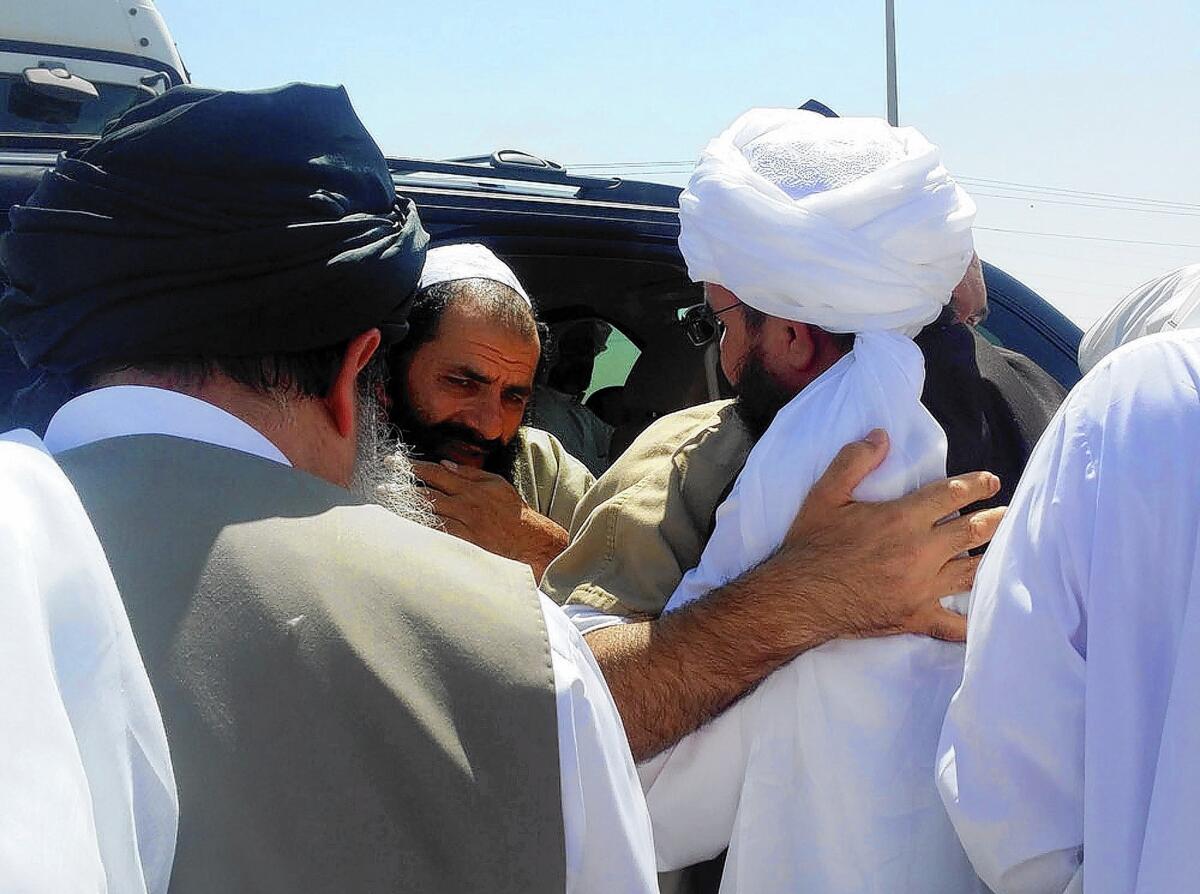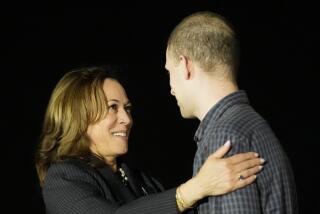Most of 5 freed Taliban prisoners have less than hard-core pasts

Reporting from KABUL, Afghanistan — Arriving in the western Afghanistan city of Herat in the late 1990s during Taliban rule, Pakistani journalist Rahimullah Yusufzai expected a locked-down, cowering population.
Instead, he heard residents openly criticize the militant Islamic movement. At the provincial government offices, he saw a parade of local clerics come to meet the governor, founding Taliban member Khairullah Khairkhwa, who greeted them in the local Persian, a language most of his comrades didn’t speak.
“He knew these people didn’t really support the Taliban, so he made an extra effort,” said Yusufzai, who has covered Afghanistan for three decades. “He was a friendly man and did not try to force his views on you.”
Khairkhwa, who was arrested by Pakistani forces in 2002 and transferred to the U.S. military prison at Guantanamo Bay, Cuba, was among the five Taliban detainees released by the Obama administration last week in exchange for captive U.S. Army Sgt. Bowe Bergdahl. Obama critics have said the swap could endanger American lives, with Sen. John McCain (R-Ariz.) calling the five Taliban members “the hardest and toughest of all.”
A closer look at the former prisoners, however, indicates that not all were hard-core militants. Three held political positions in the Taliban government that ruled Afghanistan from 1996 to 2001 and were considered relative moderates. A fourth was a mid-level police official, experts say.
The fifth, however, has a darker past. Mohammed Fazl was chief of staff of the Taliban army and is accused of commanding forces that massacred hundreds of civilians in the final years of Taliban rule before the 2001 U.S.-led invasion. He was arrested in November 2001 after surrendering to U.S.-allied warlords in northern Afghanistan.
“Fazl is the only one of the five to face accusations of explicit war crimes and they are, indeed, extremely serious,” Kate Clark of the Afghanistan Analysts Network, a Kabul-based research group, wrote in a commentary published Wednesday.
The backgrounds of the prisoners, who are confined to the Persian Gulf nation of Qatar for one year under the terms of the exchange, indicate that they would have little utility on the battlefield after more than a decade in prison. They range in age from 43 to 47. In their absences, the Taliban movement they served has evolved into a complex and extremely violent insurgency that routinely kills civilians and has been decimated — although far from defeated — by years of U.S. counter-terrorism operations.
Their primary value, say analysts, is as a symbol of the Taliban’s ability to negotiate on equal footing with the United States. As the Obama administration prepares for the withdrawal of most U.S. forces from Afghanistan by the end of the year, the exchange has raised questions about whether Taliban leaders will seek a negotiated peace with the Afghan government or wait out the departure of virtually all American troops by 2016.
“It’s a boost in terms of morale, but I doubt whether this would make any kind of practical impact, at least in the short term, to the conflict inside Afghanistan,” said Alex Strick van Linschoten, who has co-written three books on the Taliban. “All these guys are pretty old now.”
Administration officials dispute allegations that the five were the “worst of the worst” of the Taliban, saying they were not a threat to the United States and that about 30 detainees who are considered a danger would still face trial.
“These were not good guys. I am in no way defending these men. But being, you know, mid-to-high-level officials in a regime that’s grotesque and horrific also doesn’t mean they themselves directly pose a threat to the United States,” State Department spokeswoman Marie Harf said Thursday. She accused critics of the release of having a political motive.
U.S. officials, who had sought for several years to swap the Taliban detainees for Bergdahl, previously had described the men as violent extremists in prison documents obtained by the anti-secrecy group WikiLeaks.
One of the five, Mullah Norullah Noori, is listed as “a senior Taliban military commander in [the northern city of] Mazar-i-Sharif during hostilities against U.S. and coalition forces in late 2001” who was “wanted by the United Nations for possible war crimes, including the murder of thousands of Shiite Muslims.”
But experts say Noori was a civilian official, an aide to the Taliban governor of Balkh province who later assumed the job himself and never held a military post. In Noori’s account to U.S. officials, included in his prison file, he said his job “was to ensure the government operated as usual and to resolve tribal complaints.”
In several extensive war crimes reports conducted by the United Nations, Human Rights Watch and the independent Afghanistan Justice Project, Noori’s name never appears as a suspect.
Khairkhwa, the governor in Herat, commanded a contingent of Taliban fighters who seized the provincial capital in 1997 and is described in U.S. documents as “a hard-liner in his support of the Taliban philosophy.”
The description is sharply at odds with that of journalists and analysts who met him in the late 1990s. Yusufzai, the Pakistani journalist, said Khairkhwa assiduously reached out to local clerics, including minority Shiite Muslims, to address their opposition to the Taliban.
“If you looked at a lot of the Taliban leadership, he was different,” said Yusufzai, who is with the Pakistani newspaper News International.
Another of the freed men, Abdul Haq Wasiq, was a student of Islam in his mid-20s who went to Kabul when the Taliban came to power. He worked for a relative who had been appointed the head of the intelligence service, and when the deputy intelligence chief fell ill, Wasiq took over the post, according to his prison file.
After the U.S.-led invasion, Wasiq offered his help to U.S. forces in locating the Taliban supreme leader, Mullah Mohammed Omar, but was arrested instead.
The last of the men released, Mohammed Nabi Omari, whom the U.S. labeled “a senior Taliban official who served in multiple leadership roles,” was a police chief in the southern province of Zabol but never served in the Taliban leadership, according to research by Clark and the Afghanistan Analysts Network. Experts think Omari was added to the prisoner swap because he is an associate of the Haqqani network, the Taliban offshoot that was holding Bergdahl.
The U.S. description of Omari, Clark wrote, is “nonsense.”
Where the prisoners have already had an impact is as a propaganda tool. The Taliban on Wednesday released a video of Bergdahl’s release stamped with the misspelled but clear message: “Don’come back to Afghanistan.” On Facebook and online message boards, Taliban sympathizers brag that Bergdahl emerged from five years’ captivity in good health, drawing a contrast with the torture allegations that have dogged the Guantanamo Bay prison.
Analysts believe that the ex-prisoners, if they rejoined the Taliban, would serve at most in advisory roles, saying they are too far removed from a movement that has lost many of its top leaders to U.S.-led coalition operations.
“They are not aware of what has been going on for the past 13 years,” said Waheed Muzhda, a political analyst in Kabul who served in the Taliban’s Foreign Ministry. “They don’t know who has survived and who’s been killed and what changes have come to the leadership of the Taliban.
“It will take them at least the one year [in Qatar] to catch up with what has happened in the world and in Afghanistan.”
Times staff writer Bengali reported from Mumbai, India, and special correspondent Baktash from Kabul. Times staff writer Paul Richter in Washington contributed to this report.
More to Read
Sign up for Essential California
The most important California stories and recommendations in your inbox every morning.
You may occasionally receive promotional content from the Los Angeles Times.











